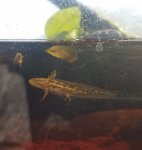skybye
New member
First of all, this site has been a rel life saver for me so wanted to give a big shout out first.
I'm a graduate student who was helping a wildlife biologist do a study on caudata egg cycles. We ended up retaining two large batches of eggs to measure hatch dates, and the larvae have been sort of dumped on me to rear. (We have a collection permit for this purpose, no worries!) We THINK that they are Eastern Tiger Salamanders and Mole Salamanders (Ambystoma talpoideum) and our knowledge of raising these was none. I think we're on the right tract now thanks to old entries from this forum.
Currently, I have two ten gallon tanks each with about 3-5 larvae each (different species in different tanks). I have removed the smallest of each and am raising them individually in small Tupperware. All have aquatic plants. We had been feeding them with copepods and daphnia fly larvae from their original ponds, but they have since dried up to nothing. I have some black worms ordered and on their way. No tanks have bubblers, I'm keeping water levels below 2".
Larvae were hatched January 17 and we have such a mix of development. Our largest (mole) is roughly an inch and a half long, where our smallest has only developed thin, see-through front limbs. Is this typical to see staggered development? We had thought maybe resources had caused this which is why they are now in different habitats.
Anyway, what timelines are you seeing for metamorphosis on your larvae? I would love to know. Does anyone have any tips or tricks that I am missing?
Again, great to be here and thanks for being such a great source of information.
I'm a graduate student who was helping a wildlife biologist do a study on caudata egg cycles. We ended up retaining two large batches of eggs to measure hatch dates, and the larvae have been sort of dumped on me to rear. (We have a collection permit for this purpose, no worries!) We THINK that they are Eastern Tiger Salamanders and Mole Salamanders (Ambystoma talpoideum) and our knowledge of raising these was none. I think we're on the right tract now thanks to old entries from this forum.
Currently, I have two ten gallon tanks each with about 3-5 larvae each (different species in different tanks). I have removed the smallest of each and am raising them individually in small Tupperware. All have aquatic plants. We had been feeding them with copepods and daphnia fly larvae from their original ponds, but they have since dried up to nothing. I have some black worms ordered and on their way. No tanks have bubblers, I'm keeping water levels below 2".
Larvae were hatched January 17 and we have such a mix of development. Our largest (mole) is roughly an inch and a half long, where our smallest has only developed thin, see-through front limbs. Is this typical to see staggered development? We had thought maybe resources had caused this which is why they are now in different habitats.
Anyway, what timelines are you seeing for metamorphosis on your larvae? I would love to know. Does anyone have any tips or tricks that I am missing?
Again, great to be here and thanks for being such a great source of information.


